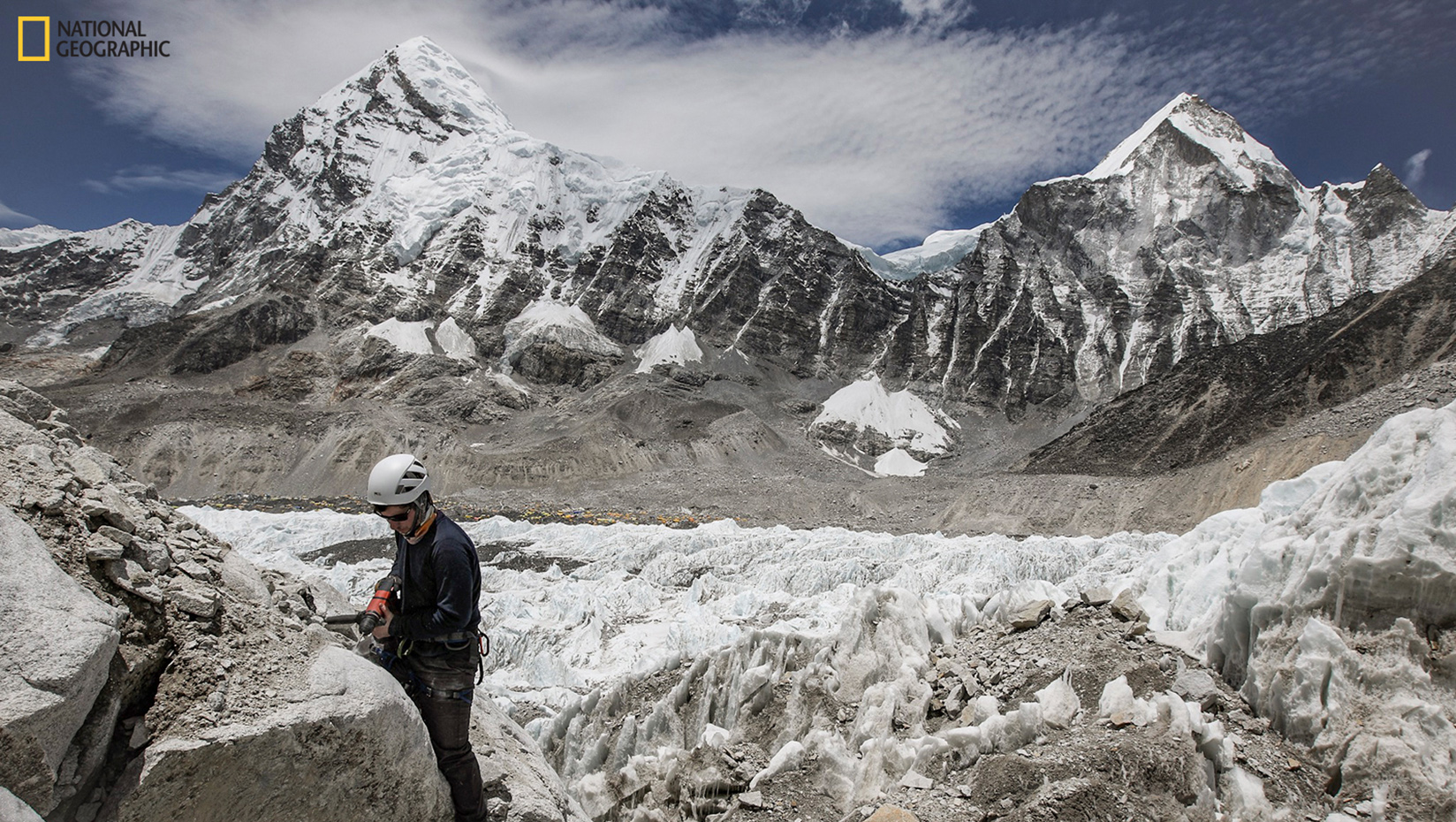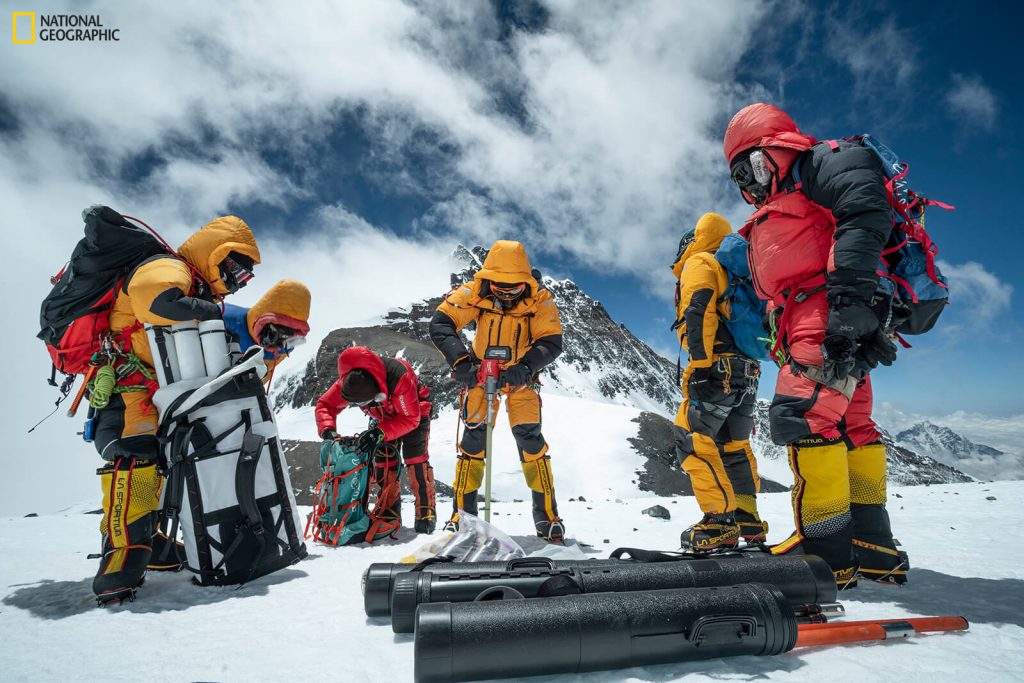
UMaine researchers take part in National Geographic, Rolex Expedition to Mt. Everest
An international team of scientists, climbers and storytellers, led by the National Geographic Society and Tribhuvan University, and supported in partnership with Rolex, conducted a scientific expedition to Mount Everest, believed to be the most comprehensive single scientific expedition to the mountain in history.
The multidisciplinary team installed the two highest weather stations in the world (at 8,430 meters and 7,945 meters), collected the highest-ever ice core (at 8,020 meters), conducted comprehensive biodiversity surveys at multiple elevations, completed the highest elevation helicopter-based lidar scan, expanded the elevation records for high-dwelling species and documented the history of the mountain’s glaciers.
Six University of Maine scientists participated in National Geographic’s Perpetual Planet Extreme Expedition to Everest.
Climate Change Institute director Paul Mayewski was expedition leader and lead scientist for the project. Mayewski, who was participating in his fourth Everest excursion, is used to extremes. The world-renowned climate scientist and explorer has led nearly 60 climate science treks around the globe, including many in Antarctica.
“This is a new window into the planet,” Mayewski told National Geographic. “We believe the best way to do science on Everest isn’t just to do one kind of science, but do many kinds of science.”
Mayewski will take part in a livestream panel discussion titled Fueling Earth’s Engines with other Perpetual Planet Extreme Expedition leaders at 9:05 a.m. Thursday, June 13 in Washington, D.C.
UMaine doctoral candidate Mariusz Potocki climbed nearly as high as jetliners fly to collect the world’s highest ice core on South Col. He used an off-the-shelf ice-coring instrument modified by the university’s Advanced Manufacturing Center to collect the core. UMaine’s laser technology that yields 10,000 samples per year in ice cores will provide details about the chemistry of the atmosphere above 8,000 meters.

UMaine Earth and climate sciences assistant professor Aaron Putnam led a geology team that included UMaine Ph.D. candidate Peter Strand, and Quaternary and climate science master’s student Laura Mattas.
And UMaine doctoral student Heather Clifford, who was stationed at base camp, collected snow, ice and stream water samples to analyze for persistent organic pollutants and microplastics.
Studies have shown that the glaciers of the Hindu Kush–Himalaya, where Mt. Everest is located, are rapidly disappearing due to increasing global temperatures.
The extreme conditions of high-elevation mountain ranges have made studying the true impacts of climate and environmental changes nearly impossible.
As a result, there are critical knowledge gaps about the history of these glaciers, and about future impacts that their disappearance would have on the lives and livelihoods of the more than one billion people in the region who depend on the reliable flow of water these glaciers provide.
With team members from eight countries, including 17 Nepali researchers, the expedition team conducted trailblazing research in five areas of science that are critical to understanding environmental changes and their impacts: biology, glaciology, meteorology, geology, and mapping.
More in-depth information about the initial scientific findings and their significance is here.
The Everest expedition is part of National Geographic’s newly established Life at the Extremes program, and is the first in a series of Perpetual Planet Extreme Expeditions that are supported by a renewed and expanded partnership between National Geographic and Rolex.
The expeditions aim to explore and better understand some of the most extreme environments on planet Earth. Data collected from the Perpetual Planet Extreme Expeditions in these environments will support new decision-making tools, called Perpetual Planet Extreme Indices, which will provide real-time and historical data on the factors that contribute to the health of these ecosystems.
Additionally, to underscore the urgency of the team’s work, the scientific research conducted by the expedition team will be complemented by coverage in National Geographic’s robust portfolio of media assets, including on NationalGeographic.com and in National Geographic magazine.
”Climate change is one of the biggest challenges facing humanity and there is still much to learn about how it’s already altered the world, from the deepest parts of the ocean to its tallest mountains,” said Jonathan Baillie, executive vice president and chief scientist at the National Geographic Society.
“By harnessing our 131-year history of exploration and venturing into some of the most extreme environments on the planet, we will fill critical data gaps on the world’s life support systems and drive solutions to assure that they can continue to fuel our future.”
Follow updates from the Perpetual Planet Extreme Expedition: Everest and explore historical and new data about the role of Mount Everest as a water tower for the region at www.natgeo.com/everest.
For more on the Life at the Extremes program, visit www.natgeo.org/extremes.
Contact: Fae Jencks, National Geographic Society, fjencks@ngs.org; Beth Staples, 207.404.0708
